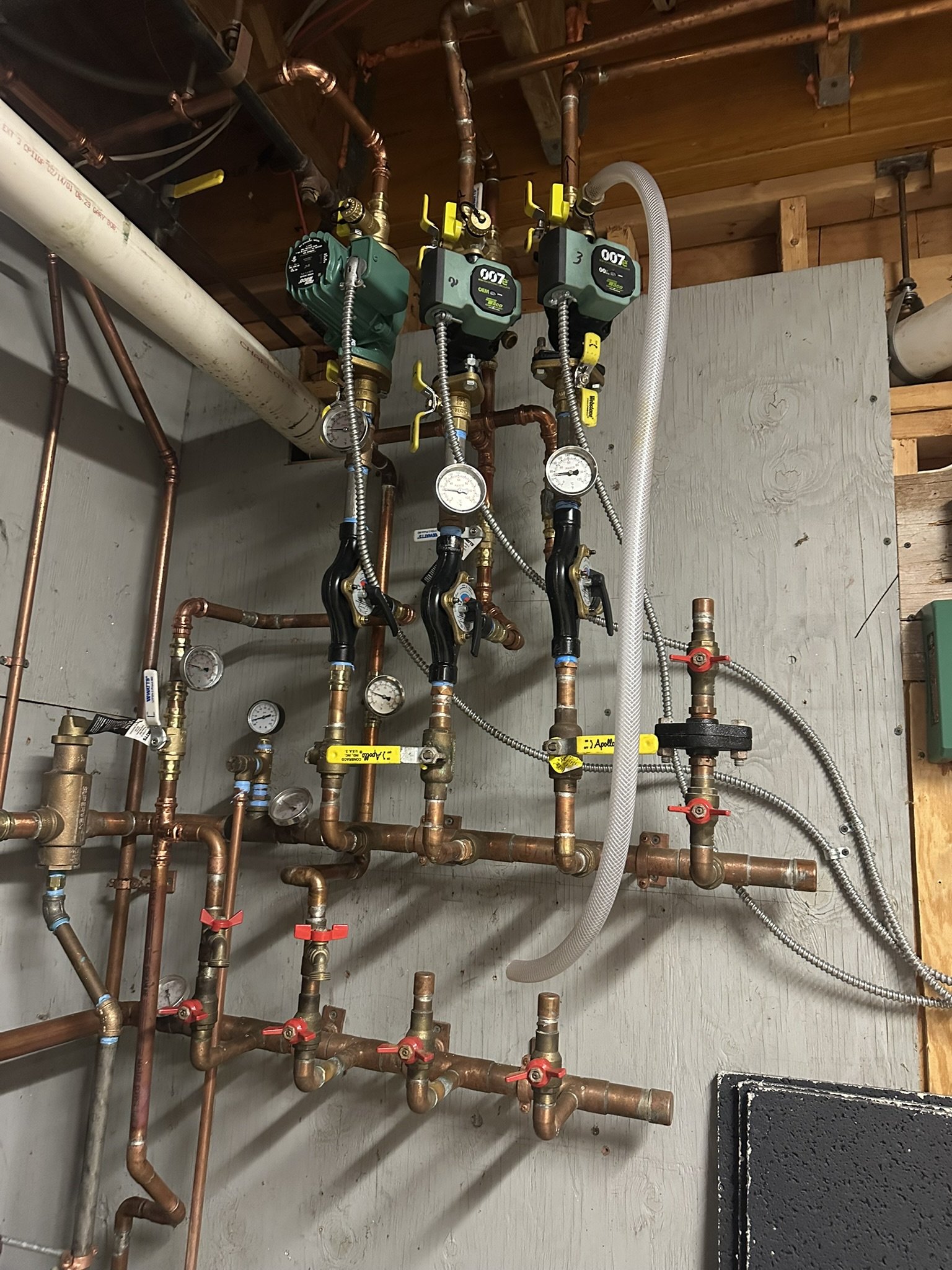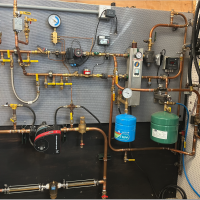Installing new bathroom zone on a pretty screwed up system
Hi all,
I purchased my ~4000sq ft house during covid and have had non-stop issues with the radiant system. It is a DIY system installed by the homeowner ~25 years ago from a company in Vermont called Radiantec.
The system consisted of a Polaris 50gal water heater feeding three zones: 1 zone for basement slab and 2 zones for upstairs with 7/8" staple up pex.
This seems very unusual to me but there are no zone manifolds. The basement slab zone is 1 singular loop covering a ~2000 sq ft area. The 2 upstairs zones use what Radientec calls "long manifolds", which is, from their manual:
"Still another option is to build what is called a long manifold. This is nothing more than a length of copper pipe that spans the entire zone and then tees off to the different circuits. You then have a return line that does the same and brings the water back to the water heater."
In my case both upstairs zones feed into the same copper return line. This all feels wrong to me?
I have recently replaced the water heater with a Viessmann Vitodens 200-W combi-boiler, installed mixing valves, and replaced the pumps.
I'd like to give my master bath its own zone (it has tile flooring and is always cold), but want to get away from this long manifold system, which, to be honest, seems like total junk.
Right now my plan is to add another mixing valve, pump, and then a single 1/2" pex loop for the bathroom. I am not planning on using a manifold since there is only one loop.
Current
Proposed
Does my plan make sense? How screwed up (or not) is my system. Please, I welcome all feedback / comments / etc.
Comments
-
The supply main and return main connecting to the loops will work if the loop lengths are reasonable and there are balancing valves at the main connections. If there aren't balancing valves you might be able to make it work ok with constant circulation and outdoor reset.
The issue with zoning your bathroom separately is that it needs to be close to the minimum firing rate of the boiler or more. If it is the only zone calling and can't dissipate the minimum the boiler can output the boiler will short cycle. You could mitigate this by only running it with other zones or adding a buffer tank. If you only run it with the rest of the heating the only runs with another zone will work. If you want to warm the bathroom in shoulder seasons without the rest of the house it becomes more complicated, you need a buffer tank or something. If you picked a boiler sized to the heat loss of the house with a 10:1 turndown ratio it might have a minimum firing rate that matches the bathroom zone.
1 -
I am guessing this is not a balancing valve. So if I install balancing valves, I can leave existing supply main, return, and loops as is? Is there any benefit to splitting the shared return into a separate return for each zone?
I am wondering if after I install balancing valves, the bathroom will no longer need its own zone. Since it is at the very end of the supply main, I don’t think there’s currently much hot water reaching that loop.
0 -
re: minimum firing rate I feel like the Vitodens can handle this, but I’m not knowledgeable enough to say why. Hopefully someone else can chime in. I do know it ramps up heating curve slowly and uses outdoor temp to determine flow temp.
0 -
If the common return is big enough it should be ok. i have a little bit of a concern if you are doing mixing to reduce the temps in the loops but I don't think that will be a problem.
If you have access to each loop connection adding balancing valves will make it act the same as if it were a manifold. It is an unconventional way to do it but if you have a way to balance it and the mains are large enough this part of it should work.
I am concerned that the loops are short enough to get adequate flow through them. Others can help you figure that out.
The bathroom with tile in backer board will act differently than the tubing under wood so it is likely it would be difficult to get them to balance on the same zone.
Is the pex in the loops really 7/8" 3/8" or 1/2" is more typical and 7/8" is really hard to work with.
2 -
The mains are 1”, the pex is labelled 7/8”. Based on the number of repair couplings I’m sure it was very hard to work with…
The entire ceiling is drop tile so everything is accessible.0 -
-
That bathroom zone is way too small for such a big boiler even on low fire. The simplest is to tag it onto the main main distribution right by it with a small local pump+thermostat.
If you want to run it back to the main manifold, you can but have to add a buffer or you would have to add some logic so the zone never runs on its own.
Simplest would be a relay driven by the boiler circ in series with the bathroom zone circ power. This way the even if the bath is calling for heat, it would only run the circ if another zone is running.
Also watch those Radiantech pipes are usually not oxygen barrier. You have to watch what you connect up to it as it can't be steel. Not sure if the Weismann will like it either.
I also see mixing valves there. With a modcon, you never want to be mixing. Set the outdoor curve so the zones have good runtimes without any mix. This is basically free fuel savings with no drawback.
2 -
Let me take a step back and give some exposition.
We run our heat Nov-April and have house set to constant 68.
First winter, house was hitting 60-61 and water heater was always running with $1200 in propane every three-four weeks.
That compelled us to have 14” blown in insulation in attic. That had big impact, but living area still struggled to stay warm while finished basement was 70 degrees.I installed digital thermostats and bought a thermal imaging gun. That led to discovery the basement zone never turned on all winter, which then led to discovery the staple up pex didn’t have aluminum heat transfer plates or insulation underneath, so heat was just staying in basement.
Now, I’ve installed plates and insulated everywhere and foamed header joist and bought the Weissmann. This winter we were finally comfortable, except for master bath which is still 62-63.
We have temp sensors along the zone that includes master bath, and thermostat takes average. When master bath is cold, which it always is, entire zone turns on, so master bath hits maybe 65 while the bedrooms are 71.
So here we are, with me wanting to install separate zone for bathroom, to keep rest of house from getting hot when heat is needed for bathroom.
0 -
“The simplest is to tag it onto the main main distribution right by it with a small local pump+thermostat.”
can you clarify this? You mean tap into the, I guess, “long manifold” or whatever radiantec calls it. That is the current setup, so I should add pump where 1” copper feeds bathroom loop?
0 -
the bathroom will need longer cycles at a lower temp because it has more mass than the plywood.
0 -
“I also see mixing valves there. With a modcon, you never want to be mixing. Set the outdoor curve so the zones have good runtimes without any mix. This is basically free fuel savings with no drawback.”
Thank you for this
0 -
what if I split zone 2 in half, with master bath and bed getting its own zone? I want to say this is ~500 sq ft.
0 -
you need the calculation of the output of the loops and the specs of the boiler.
0 -
It sounded like you were adding a new bath. If the issue is with existing not being hot enough, the solution is much simpler.
Add balancing valves to all the loops before the bath zone to restrict the flow. This will reduce how much heat gets to the bedrooms so the thermostat calls are longer and get more heat to the bath. Simple to do and doesn't require any new controls nor does it create micro zoning issues.
2 -
Thank you both!!
0 -
Radiantec is the bane of Vermont and all of their clients who "fall victim". I have encountered too many of those systems. You did the biggest correction by adding a Viessmann boiler, transfer plates and insulating below the stapled-up 7/8 tubing. It might help if you insulated the 1" "long manifolds" so that more heat could get to the indiv. 7/8" loops. The floor sections with 1" manifold must be "plenty warm"! It seems like your challenge is to balance the flow, set the Viessmann boiler program properly and let IT decide the water temperature—not the indiviual mixing valves. Something close to constant flow would be best.
1 -
I think Viessmann states boiler must not be connected to non barrier tube in their installation manual. Hopefully it is barrier tube. Although there could be O2 ingress at those fittings.
For under 160 sq ft, you might consider electric mat in the bath?
Bob "hot rod" Rohr
trainer for Caleffi NA
Living the hydronic dream1 -
I would get rid of the mixing valves unless you need multiple temperatures. If you need multiple temperatures then you should either get the actuators and control for those valves to program the boiler for each temp call, or install a thermostatic mixing valve. If this is a US boiler then you don't have a vitodens 200 combi because there is no such boiler, they only make the 100 series in a combi for the US market and the 100 will not control viessmann mixing valves.
0 -
@Kaos makes a good point. I made the mistake of installing a Viessmann Vitodens 200-W with a low-loss header on a system with non-barrier tubing in 2016. The boiler has been working fine, but the low-loss header developed a nice hole in a matter of months.
Check your Radiantec tubing to see if it has an oxygen barrier.
8.33 lbs./gal. x 60 min./hr. x 20°ΔT = 10,000 BTU's/hour
Two btu per sq ft for degree difference for a slab1 -
I’m nervous on the pex now, will contact Radientec tomorrow to see if it has barrier. Here’s a screenshot of the tube
The Radiator is a Vitodens 200-W.B2HE-199.
0 -
I am replacing all the crappy fittings and putting in balancing valves. I think it’s going to resolve the last of our problems with this system.
And insulate the 1” copper manifold, @psb75 you are right about those rooms being toasty.
It sounds like the mixing valves weren’t needed, darn those were expensive. Two of the zones are staple up pex under nailed down maple (yep) and one is in slab which I run hotter but probably don’t need to.
0 -
Ok, the pex is not oxygen barrier but there is a plate heat exchanger between the closed loop system and the radiator, you can see it in the first photo just to the right of the radiator.
0 -
The circulators should be nonferrous, i don't think they are but I can't tell for certain. you can wait until they fail to replace them, it won't really hurt anything, they will just eventually seize up.
0 -
Categories
- All Categories
- 87.3K THE MAIN WALL
- 3.2K A-C, Heat Pumps & Refrigeration
- 61 Biomass
- 429 Carbon Monoxide Awareness
- 120 Chimneys & Flues
- 2.1K Domestic Hot Water
- 5.8K Gas Heating
- 114 Geothermal
- 166 Indoor-Air Quality
- 3.7K Oil Heating
- 77 Pipe Deterioration
- 1K Plumbing
- 6.5K Radiant Heating
- 395 Solar
- 15.7K Strictly Steam
- 3.4K Thermostats and Controls
- 56 Water Quality
- 51 Industry Classes
- 50 Job Opportunities
- 18 Recall Announcements










